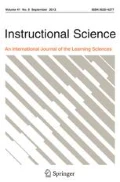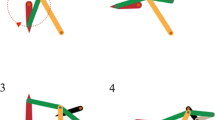Abstract
In research on learning with animations compared to static pictures usually very short and narrowly defined topics are chosen. However, in school contexts such topics are often extended by additional information (i.e., information that is related to a given topic, but not essential for this topic). In the current study, that took place in a school context, it was investigated which role additional information would play when learning with animations compared to static pictures. It was hypothesized that there would be a beneficial effect of the animation, that additional information would impede learning the original topic and that the beneficial effect of the animation compared to the static picture would be even more pronounced when additional information is presented compared to when no additional information is given. A 2 × 2 between-subject design, with visualization format (animation vs. static picture) and additional information (present vs. absent) as independent variables, was used (N = 199 high school students). Learning outcomes were analysed by means of a focal contrast analysis that corresponded to the stated hypotheses. Results revealed that the hypotheses were not met for factual knowledge tasks, but for transfer tasks: Additional information hindered learning, and the advantage of the animation over the static picture was more pronounced when additional information was presented. However, it should be noted that learners receiving additional information performed better on questions about the additional information than learners without additional information. Implications of these results are discussed.

Similar content being viewed by others
Notes
This reasoning may be at first glance supported by the subjective ratings of content complexity, difficulty and effort. However, this type of evidence should be treated very cautiously, since we did not measure cognitive load directly after the presentation of additional information, but only once after the learning phase. Moreover, the conditions with additional information took more time. Due to this confound, it may be the case that these results do not reflect higher cognitive load, but, for instance, the invested additional time (cf. Van Gog et al. 2012).
References
Abelson, R. P., & Prentice, D. A. (1997). Contrast tests of interaction hypothesis. Psychological Methods,2(4), 315–328. https://doi.org/10.1037/1082-989X.2.4.315.
Ayres, P., & Paas, F. (2007). Making instructional animations more effective: A cognitive load approach. Applied Cognitive Psychology,21(6), 695–700. https://doi.org/10.1002/acp.1343.
Berney, S., & Bétrancourt, M. (2016). Does animation enhance learning? A meta-analysis. Computers & Education,101, 150–167. https://doi.org/10.1016/j.compedu.2016.06.005.
Buckless, F. A., & Ravenscroft, S. P. (1990). Contrast coding: A refinement of ANOVA in behavioral analysis. The Accounting Review,1990(65), 933.
Castro-Alonso, J. C., Ayres, P., & Paas, F. (2014). Learning from observing hands in static and animated versions of non-manipulative tasks. Learning and Instruction,34, 11–21. https://doi.org/10.1016/j.learninstruc.2014.07.005.
Cierniak, G., Scheiter, K., & Gerjets, P. (2009). Explaining the split-attention effect: Is the reduction of extraneous cognitive load accompanied by an increase in germane cognitive load? Computers in Human Behavior,25(2), 315–324. https://doi.org/10.1016/j.chb.2008.12.020.
Cohen, J. (1988). Statistical power analysis for the behavioral sciences (2nd ed.). Hillsdale, NJ: Erlbaum.
De Koning, B. B., Tabbers, H. K., Rikers, R. M. J. P., & Paas, F. (2011). Attention cueing in an instructional animation: The role of presentation speed. Computers in Human Behavior,27(1), 41–45. https://doi.org/10.1016/j.chb.2010.05.010.
Eitel, A., & Kühl, T. (2019). Harmful or helpful? The impact of seductive details on learning and instruction. Applied Cognitive Psychology,33, 3–8. https://doi.org/10.1002/acp.3513.
Ekstrom, R. B., French, J. W., Harman, H. H., & Dermen, D. (1976). Manual for kit of factor-referenced cognitive tests. Princeton: Educational Testing Service.
Hayes, A. F., & Krippendorff, K. (2007). Answering the call for a standard reliability measure for coding data. Communication Methods and Measures,1(1), 77–89. https://doi.org/10.1080/19312450709336664.
Hegarty, M. (2004). Dynamic visualizations and learning: Getting to the difficult questions. Learning and Instruction,14(3), 343–351. https://doi.org/10.1016/j.learninstruc.2004.06.007.
Höffler, T. N., & Leutner, D. (2007). Instructional animation versus static pictures: A meta-analysis. Learning and Instruction,17(6), 722–738. https://doi.org/10.1016/j.learninstruc.2007.09.013.
Kilpatrick, J., Swafford, J., & Findell, B. (Eds.). (2001). Adding it up: Helping children learn mathematics. Washington, DC: National Academy.
Klepsch, M., Schmitz, F., & Seufert, T. (2017). Development and Validation of Two Instruments Measuring Intrinsic, Extraneous, and Germane Cognitive Load. Frontiers in Psychology,8, 1997. https://doi.org/10.3389/fpsyg.2017.01997.
Kühl, T., Scheiter, K., Gerjets, P., & Edelmann, J. (2011). The influence of text modality on learning with static and dynamic visualizations. Computers in Human Behavior,27(1), 29–35. https://doi.org/10.1016/j.chb.2010.05.008.
Kühl, T., Scheiter, K., & Gerjets, P. (2012). Enhancing learning from dynamic and static visualizations by means of cueing. Journal of Educational Multimedia and Hypermedia,21(1), 71–88.
Kühl, T., Navratil, S. D., & Münzer, S. (2018a). Animations and static pictures: The influence of prompting and time of testing. Learning and Instruction, 58, 201–209. https://doi.org/10.1016/j.learninstruc.2018.07.006.
Kühl, T., Stebner, F., Navratil, S. D., Fehringer, B. C. O. F., & Münzer, S. (2018b). Text information and spatial abilities in learning with different visualization formats. Journal of Educational Psychology, 110, 561–577. https://doi.org/10.1037/edu0000226.
Lowe, R. K. (2004). Interrogation of a dynamic visualization during learning. Learning and Instruction,14(3), 257–274. https://doi.org/10.1016/j.learninstruc.2004.06.003.
Lowe, R. K., & Schnotz, W. (2014). Animation principles in multimedia learning. In R. E. Mayer (Ed.), The Cambridge handbook of multimedia learning (pp. 513–546). New York: Cambridge University Press.
Mayer, R. E. (2009). Multimedia Learning. Cambridge: Cambridge University Press.
Mayer, R. E., & Jackson, J. (2005). The Case for Coherence in Scientific Explanations: Quantitative Details Can Hurt Qualitative Understanding. Journal of Experimental Psychology. Applied,11(1), 13–18. https://doi.org/10.1037/1076-898X.11.1.13.
Niedenthal, P. M., Brauer, M., Robin, L., & Innes-Ker, Å. H. (2002). Adult attachment and the perception of facial expression of emotion. Journal of Personality and Social Psychology,82(3), 419–433. https://doi.org/10.1037/0022-3514.82.3.419.
Paas, F. (1992). Training strategies for attaining transfer of problem-solving skill in statistics: A cognitive-load approach. Journal of Educational Psychology,84(4), 429–434. https://doi.org/10.1037/0022-0663.84.4.429.
Paas, F., & Sweller, J. (2014). Implications of cognitive load theory for multimedia learning. In R. E. Mayer (Ed.), The Cambridge handbook of multimedia learning (pp. 27–42). New York: Cambridge University Press.
Pashler, H., & Wagenmakers, E. (2012). Editors’ Introduction to the Special Section on Replicability in Psychological Science: A Crisis of Confidence? Perspectives on Psychological Science,7, 528–530. https://doi.org/10.1177/1745691612465253.
Rey, G. D. (2012). A review of research and a meta-analysis of the seductive detail effect. Educational Research Review,7(3), 216–237. https://doi.org/10.1016/j.edurev.2012.05.003.
Schnotz, W., & Lowe, R. K. (2008). A unified view of learning from animated and static graphics. In R. K. Lowe & W. Schnotz (Eds.), Learning with animation: Research and design implications (pp. 304–356). New York: Cambridge University Press.
Sweller, J., Ayres, P., & Kalyuga, S. (Eds.). (2011). Cognitive load theory. New York: Springer.
Tversky, B., Bauer-Morrison, J., & Bétrancourt, M. (2002). Animation: Can it facilitate? International Journal of Human-Computer Studies,57(4), 247–262. https://doi.org/10.1006/ijhc.2002.1017.
Van Gog, T., Kirschner, F., Kester, L., & Paas, F. (2012). Timing and frequency of mental effort measurement: Evidence in favor of repeated measures. Applied Cognitive Psychology,26, 833–839. https://doi.org/10.1002/acp.2883.
Verkoeijen, P., & Tabbers, H. (2009). When quantitative details impair qualitative understanding of multimedia lessons. Educational Psychology,29(3), 269–278. https://doi.org/10.1080/01443410902795586.
Funding
This work was supported by the German Research Foundation (DFG) under grant agreement KU 3160/2–1. We would like to thank Sabrina Navratil for coordinating and conducting this study, Tanja Tu and Christina Dickers for helping to conduct this study and Dr. Johann Jacoby for giving advice on the contrast analyses.
Author information
Authors and Affiliations
Corresponding author
Additional information
Publisher's Note
Springer Nature remains neutral with regard to jurisdictional claims in published maps and institutional affiliations.
Rights and permissions
About this article
Cite this article
Kühl, T., Münzer, S. The moderating role of additional information when learning with animations compared to static pictures. Instr Sci 47, 659–677 (2019). https://doi.org/10.1007/s11251-019-09498-x
Received:
Accepted:
Published:
Issue Date:
DOI: https://doi.org/10.1007/s11251-019-09498-x




